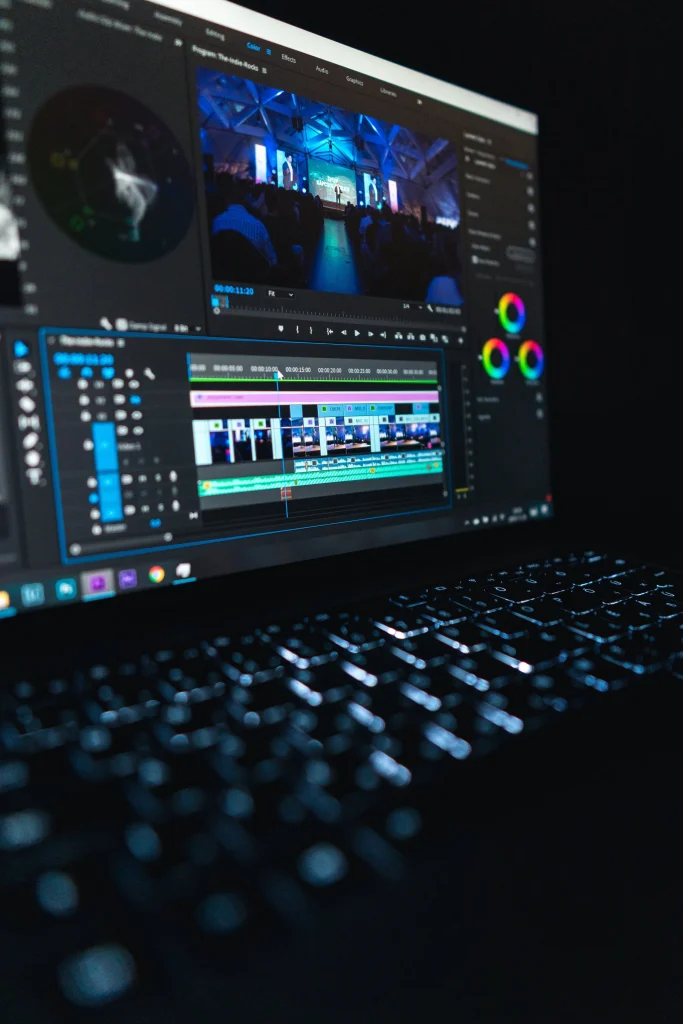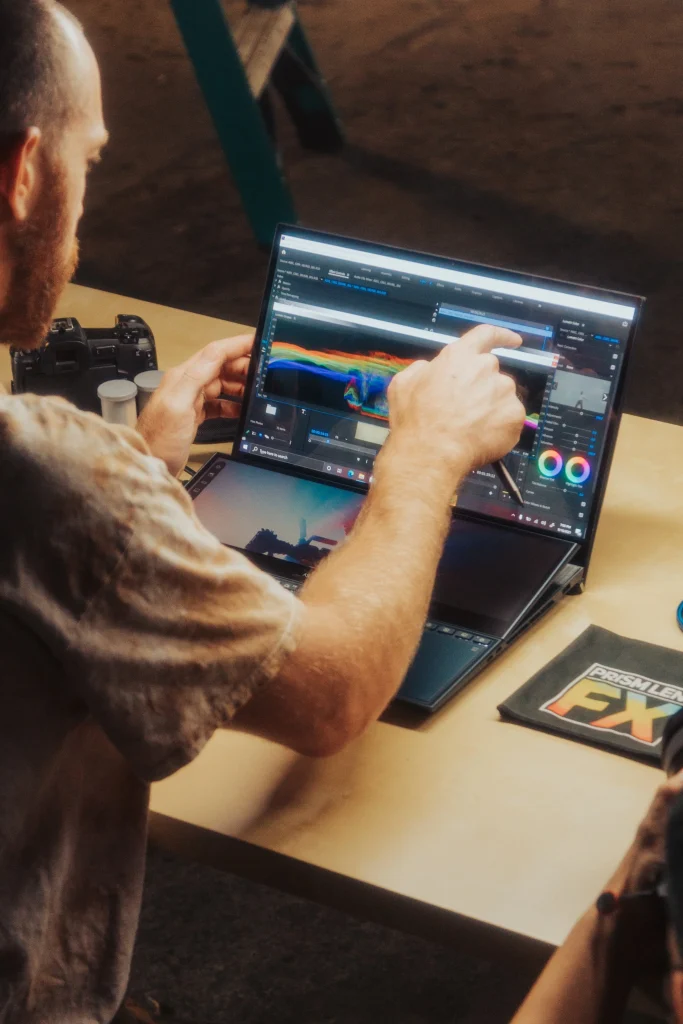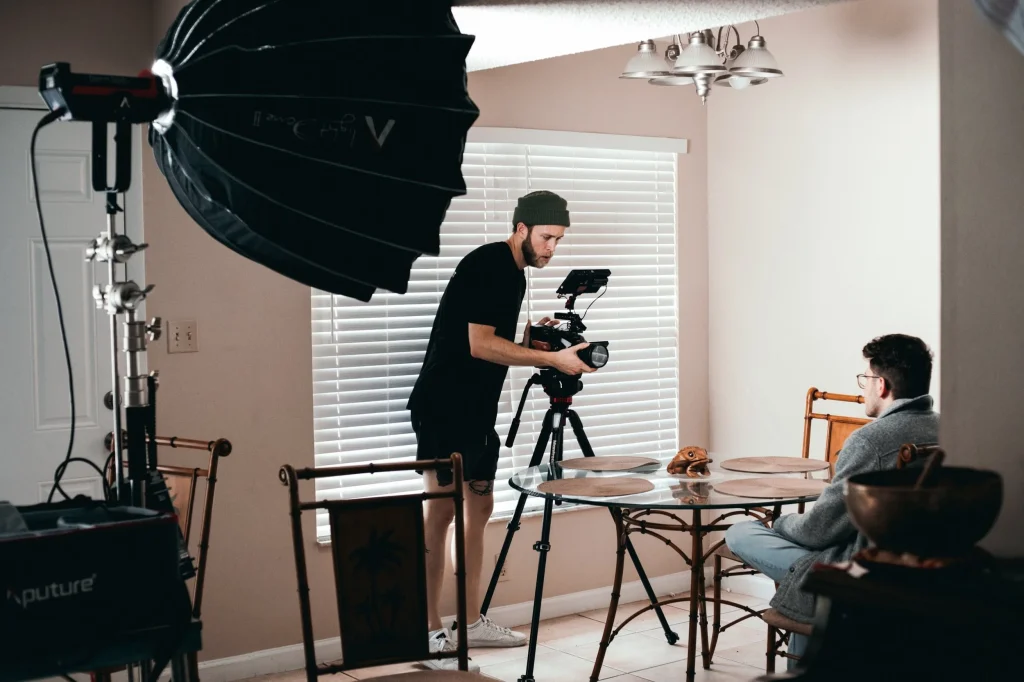What is Video Production: The Ultimate Guide to Creating Professional Videos

Video production is essential in today’s digital world, with more people consuming video content than ever before. To effectively capture the attention of your viewers and relay a message to them, it’s important for everyone – businesses included – to understand what goes into creating high-quality videos. So, let’s jumpstart this process by diving deep into understanding all aspects of video production!
Key Takeaways
- What is video production? Video production is a critical tool for creating engaging visuals that help businesses and content creators connect with their audience.
- Pre-production, production techniques & post-production are key phases of video creation, while different types of videos (corporate, product & educational) can effectively reach their respective target audiences.
- Proper planning and organization, along with effective storytelling, are necessary for successful video projects. Distribution & promotion strategies should also be utilized to maximize ROI.
Understanding Video Production

The video production process involves the creation of content with a camera. The process includes multiple phases such as preparation and filming to modification and distribution. Utilizing video production successfully for advertising is beneficial in connecting people emotionally, advocating brands, plus delivering critical statements visually.
In today’s crowded digital environment, companies must capitalize on this process to stand out from the crowd, while fostering powerful connections with their followers.
The Evolution of Video Production
Video production, which started out with black-and-white photographs and the invention of a phenakistoscope before moving on to film development and more recently digital video technology, has kept up with consumer needs over time. Social media videos, corporate videos for marketing purposes, TV productions as well as virtual reality experiences are all now part of this ever-growing field in modern-day culture.
The video production industry is continuously advancing and allows for any video team willing to invest their time and talent, the ability to create persuasive art.
Video Production vs. Film Production
It’s true that content is converging, and the distinction between traditional “film” and “video” is fading away. However, there still exists a difference between video production and film production. In the most literal sense, the difference is technical – film production involves the use of actual film passing through a camera, while video production uses a digital medium.
Nowadays, the term “film production” is commonly used to refer to the creation of feature-length movies. On the other hand, “video production” pertains to making short video content that is intended for web distribution. It is worth noting that the term “TV production” still exists and is used to describe shows on platforms such as Netflix and other streaming services, despite the significant changes that have occurred in the medium of television since the days when broadcast networks were dominant.
Video Production vs. Videography
- The term “Video Production” encompasses the complete process of creating a content piece.
- Videography refers to the technical process of recording video footage with a camera.
Wedding or event videographers capture events, while video production involves planning, shooting, editing, and distributing professional video content.
The person responsible for overseeing the filming process in video production is still referred to as a cinematographer or director of photography. Their role involves supervising lighting, camera movement, and a team of technicians who ensure that the captured images are appropriate to convey the intended message of the video production.
The cinematographer’s responsibilities include ensuring that the images captured have the right color, focus, and other aesthetic and technical considerations that support the video’s message.
Videographers on the other hand typically capture existing footage with minimal lighting and crew.
The Role of Video Production in Marketing
Video production has emerged as a critical factor in the marketing world, with the demand for video content increasing among consumers. Video allows businesses to make meaningful connections with their target audience through visuals that can capture attention & grow brand awareness.
With this tool, companies have been able to better-connect with audiences, inspiring people to take action and helping solve their audience’s problems. Video is an irreplaceable component of strategies used by marketers today.
Key Phases of Video Production

To develop an interesting video, three fundamental stages must be worked through: pre-production, production and post-production. Each of these stages have a significant contribution to the ultimate outcome of the production.
By grasping and mastering all elements involved in creating a video from start to finish, businesses can construct exciting high quality videos and leave long-lasting impressions on those who watch them.
Pre-Production Essentials
The pre-production phase serves as the initial step toward a successful video project. It requires ample preparation, exploration, and organization in order to address potential future problems. Significant components of an efficient pre-production process include defining objectives, determining the target audience, storyboarding, scripting, and location scouting.
Dedicating time for comprehensive pre-production allows creators & business owners to ensure that their videos meet predetermined goals. Appropriate planning also helps avoid issues during the production or post-production phases that follow it.
Production Techniques
The video production process includes a production phase where the script and storyboard come to life. In this stage, techniques such as directing, lighting, and skilled camera work are crucial. Developing proficiency in these skills, alongside working effectively with those involved during filming, is key to creating compelling visuals.
Post-Production Process

The post-production stage is where footage from filming needs to be perfected into the final finished product. Post-production largely involves editing and manipulating footage. Editing typically includes enhancing visuals using effects, adjusting color settings, mixing sound clips, and compiling all clips together. Skilled editors are critical to creating videos that resonate with audiences.
Types of Video Content

Video material exists in various varieties, each tailored to a distinct intent and suited to different audiences. Corporate videos, for instance, display what companies have to offer or the services they render. Product videos explain the features and advantages of products, while educational videos provide necessary knowledge or training. Let’s take a deeper look at different types of videos.
Corporate Videos
Creating a solid corporate video can be an effective strategy to communicate with both internal and external stakeholders. Videos are essential for demonstrating company products, services and also promoting the brand image.
Corporate videos also provide businesses more control over how they want their message presented to target audiences while maintaining quality content that will leave a lasting impression.
Product Videos
Creating high-quality video marketing content can demonstrate to potential customers how a product meets their needs and solves problems. Businesses can effectively show the unique features of their products as well as build trust with audiences. Product videos, when done right, encourage customers to make purchases. Engaging visuals and compelling storytelling via product videos leads to increased sales and customer satisfaction.
Educational Videos
Educational videos offer an interactive and captivating way to provide viewers with helpful data, lessons, and training. Educational videos can be used to outline complicated theories, teach practical skills, and communicate step-by-step instructions. By leveraging educational video material in your marketing strategy, you are able to get your message across effectively while also sharing valuable knowledge with your audience. Companies/creators can educate their followers while establishing authority as subject experts.
In-House vs. Outsourcing Video Production

When it comes to creating video content, businesses must decide whether they will utilize in-house production methods or hire external professionals. Each option has its respective benefits and drawbacks depending on various conditions such as the budget, expertise required for execution, and size/scale of project needed.
Benefits of In-House Production
Internal video production crews enable corporations to monitor their video output and ensure it aligns with their brand objectives. Dedicated teams can result in significant savings compared to outsourcing for the same task. Faster video turnaround times are also a potential benefit as everything will be completed internally.
Advantages of Outsourcing
By utilizing the services of an external production team, businesses can tap into specialized knowledge and experience in video creation that may not otherwise be accessible. This yields higher quality outcomes than what could have been achieved internally while also providing a greater range of creative options to choose from.
Outsourcing saves time for companies as they don’t need to use internal resources. Instead, companies can focus on their core functions with confidence, knowing their videos are being created by experts.
Essential Video Production Equipment

Video production equipment includes cameras for capturing videos, sound gear to record audio tracks, lighting equipment, and tools needed for post-production editing.
Access to a reliable collection of equipment allows businesses or producers to meet professional standards while effectively delivering their message to audiences. In this section, we’ll go through various gear required for successful video production.
Camera Options
Choosing the right camera is essential for obtaining quality footage. Different types of cameras can be used such as smartphones, DSLRs (Digital Single Lens Reflex), mirrorless models, and professional-grade cinema options. Each type of camera comes with various features & benefits depending on your budget.
Audio Equipment
Video production requires high-quality audio to guarantee your message is heard clearly. Equipment for audio capture includes microphones, mixers and recorders. Each piece of equipment plays an essential role in capturing pristine sound. Investing in proper equipment (and skilled operators) is arguably more important than video quality for the success of your production.
Lighting Essentials
Creating videos with a professional look requires the perfect ambiance and mood, which can be accomplished through purposeful lighting. Good lighting can take your video content’s visual quality up a notch, add dimensionality to subjects, and set its general tone.
In order to achieve impressive results while producing videos, consider using LED lights, softboxes or reflectors, and colored gels. These tools work in harmony to help shape light and create color palettes that provide a specific look for your videos. Cinematic lighting goes a long way toward establishing atmosphere and mood – ultimately drawing viewers into the content on screen. Therefore, investing in high-quality lighting equipment and learning how to shape and manipulate light – is absolutely crucial in taking your video production to the next level!
Tips for Successful Video Production

To create engaging videos, effective planning, organization, and storytelling skills are essential – equipment alone is not enough.
This section of the guide covers every stage of making a quality video. From scripting to editing music & sound effects through distribution. The steps outlined here will help ensure your project has maximum impact on its audience when released out into the world!
Planning and Organization
The video production process involves careful planning & organization in order to be successful. From defining objectives and identifying your target audience to structuring each step along the production process in detail, such diligence can help stave off any potential issues while optimizing resources during creative problem-solving sessions.
Organizing all areas of pre-production allows you greater control over every stage from start to finish.
Effective Storytelling
Storytelling is central to any successful video production. Leveraging compelling stories and engaging content, businesses can grab their audience’s attention while efficiently passing on their message.
Factors that make storytelling effective include concentrating on the issue at hand, the solution to the problem, keeping videos short yet informative, and consistently introducing visual or audio elements that will keep viewers engaged.
Companies can create lasting impressions by using these video techniques effectively.
Distribution and Promotion

Distribution and promotion is an often overlooked aspect of the video production process. Great videos are not very useful if they don’t reach anyone. Consider posting on social media platforms, writing blog posts or articles incorporating videos, sending videos to prospects, integrating them onto landing pages, and running paid advertisements.
Summary
In order to create successful video content, it is vital for businesses and content creators to master the entire video production process.
Proper equipment for your production is important as well in order to bring your story to life.
The process of planning, organizing, and creating a compelling storyline should be appropriately incorporated into each step of the production process to create an end product that hits its mark.
Once your video is finalized, you should plan to get traction by using a thoughtful marketing and distribution plan.
Frequently Asked Questions
What is the purpose of video production?
Video production allows companies and individuals to use video content to engage, educate and motivate their viewers. Examples include commercials, online ads, product presentations, corporate videos, and employee training clips. Video production brings visuals and audio together in order to tell compelling stories and persuade viewers to take action.
What are the 5 types of video production?
Video production can be utilized to create gripping visuals with five main types available. The five types of video production include educational videos, promotional videos, informational videos, documentaries, & entertainment.
What is the difference between video editing and video production?
The process of video production involves the capture, processing, and editing of footage to create a complete video. Video editing is then responsible for taking this raw material and assembling everything into one polished piece. Both are crucial steps in creating high-quality videos.
What is the difference between video production and film production?
Film production involves capturing images on a physical film medium, whereas video production requires that visuals be recorded with memory cards.
